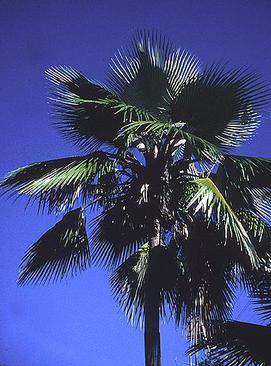Stickybud pritchardia facts for kids
Quick facts for kids Stickybud pritchardia |
|
|---|---|
 |
|
| Conservation status | |
| Scientific classification | |
| Genus: |
Pritchardia
|
| Species: |
viscosa
|
The Pritchardia viscosa, also known as the stickybud pritchardia or loʻulu, is a very rare palm species. It is an endangered species, meaning there are very few of these palms left in the wild. This special palm only grows in one place: the Hawaiian island of Kauaʻi. When a plant or animal is found only in one specific area, it is called endemic.
About the Stickybud Pritchardia
The stickybud pritchardia is a medium-sized palm tree. It usually grows to be about 6 to 8 meters (20 to 26 feet) tall. Its leaves are shaped like a fan, which is why they are called "palmate." Each leaf can be about 1 meter (3 feet) long.
This palm tree produces its fruit in tight groups. Each fruit is green and shaped like a pear. They are about 4 centimeters (1.6 inches) long and 2.5 centimeters (1 inch) wide.
Where it Lives
The stickybud pritchardia lives in wet forests on Kauaʻi. You can find it in the Kalihiwai Valley. It grows at high places, between 500 and 700 meters (1,640 to 2,300 feet) above sea level.
Other plants that grow near the stickybud pritchardia include ʻaiea (Ilex anomala), ʻahakea (Bobea species), hame (Antidesma species), hāpuʻu pulu (Cibotium glacum), and kōpiko (Psychotria hexandra). These plants all live together in the same forest.
Why it's in Danger
The stickybud pritchardia is in great danger. There are only four of these palms left in the wild. This means that one big problem, like a strong hurricane or a disease, could wipe out all of them.
One of the biggest threats to this palm is rats. Rats are not native to Hawaii; they were brought there by people. These rats eat the palm's seeds. If the seeds are eaten, new palm trees cannot grow. This makes it very hard for the stickybud pritchardia to survive and increase its numbers.
People have tried to grow more stickybud pritchardia palms in other places. However, it is still very rare in its natural home. Protecting the few remaining wild palms and their seeds is very important for this species to survive.
See also
 In Spanish: Pritchardia viscosa para niños
In Spanish: Pritchardia viscosa para niños


